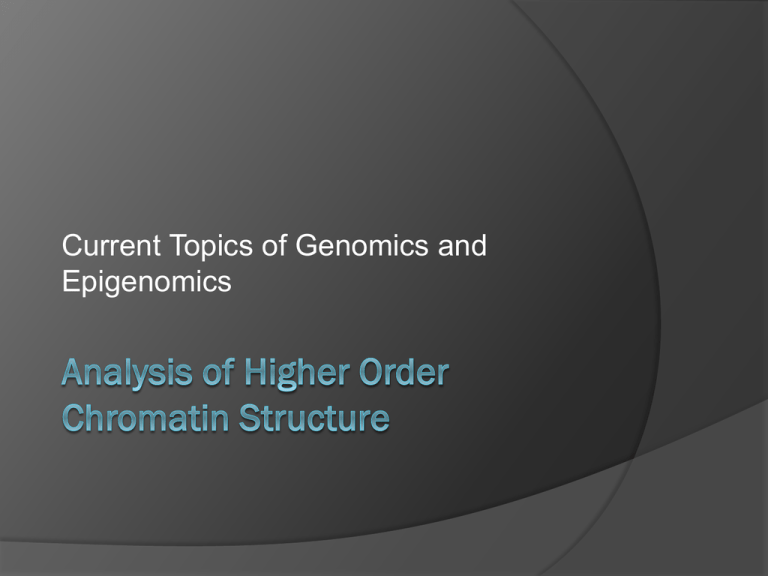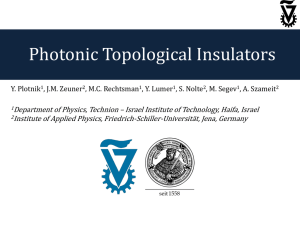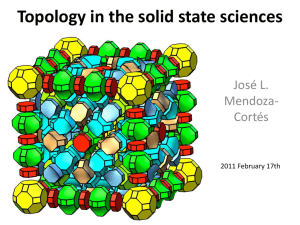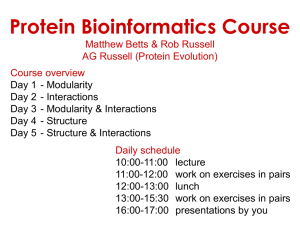Analysis of Higher Order Chromatin Structure
advertisement

Current Topics of Genomics and Epigenomics Outline Motivation for analysis of higher order chromatin structure Methods for studying long range chromatin interactions Topological domains Functional implications of topological domains Break for 5’ Paper discussion Chromosome conformation capture carbon copy (5C) Dostie et al., 2006 Chromosome conformation capture carbon copy (5C) Dostie et al., 2006 Identification of long range chromatin interaction in the human cells by 5C Sanyal et al. Nature 2012 (DOI:10.1038/nature11279) Network of long range chromatin interaction at promoters Sanyal et al. Nature 2012 (DOI:10.1038/nature11279) Network of long range chromatin interaction at promoters 50% of TSSs display one or more longrange interaction, with some interacting with as many as 20 distal fragments. Expressed TSSs interact with slightly more fragments as compared to nonexpressed TSSs Out of all distal fragments interrogated, 10% interacted with one or more TSS, with some interacting with more than 10. gene–element interactions are not exclusively one-to-one, and multiple genes and distal elements can assemble in larger clusters Sanyal et al. Nature 2012 (DOI:10.1038/nature11279) Hi-C for genome-wide analysis of higher order chromatin structure Fix Cells Digest Ligate Chromatin Biotin Labeling Lieberman-Aiden et al., 2009 Hi-C for genome-wide analysis of higher order chromatin structure Hi-C vs. FISH Mouse ES cells (from 433 Million Reads) Dixon et al., Nature, 2012 The genome is composed of megabase sized topological domains Hi-C data reveals strong local chromatin interaction domains Dixon et al. Nature 2012 The genome is composed of megabase sized topological domains Topological Domains in Mouse ES cells N = 2200 Properties of the topological domains Topological domains are stable between different cell types. hESC IMR90 Dixon et al. Nature 2012 Properties of the topological domains Topological domains are stable between different cell types. Topological domains are conserved between species Dixon et al. Nature 2012 Observations Hi-C analysis reveals that the mammalian genome consists of mega-base sized topological domains (also known as TADs). Topological domains are stable across cell types and largely preserved during evolution, suggesting that they are a basic property of the chromosome architecture. Higher order structure of the topological domains Compartment B Compartment A Lieberman-Aiden et al., 2009 Topological Domains vs. Compartment A&B Replication Timing Data 3-D model of a chromosome Structure model of the mouse Chr 2 is reconstructed using Bayesian inference approach This chromosome appears to take a helical configuration Topological domains in compartment A and B are located on different side of the chromosomal structure Red: compartment A domains Blue: compartment B domains Hu et al., PLoS Comp Bio. 2013 3-D model of a chromosome Heterochromatin and euchromatin are located on different faces of the chromosomal structure (Red: H3K9m3 enriched domains; Blue: H3K9me3 depleted domains) Hu et al., PLoS Comp Bio. 2013 3-D model of a chromosome Lamina B binding sites are clustered on one face of the chromosomal helical structure Red: enriched for Lamina B binding sites Blue: depleted for Lamina B binding Hu et al., PLoS Comp Bio. 2013 3-D model of a chromosome Transcriptionally active domains are located on one face of the chromosomal helical structure Red: enriched for RNA polymerase II binding sites Blue: depleted for RNA polymerase II binding sites Hu et al., PLoS Comp Bio. 2013 Functional implications of topological domains Prediction: Partitioning of the genome into topological domains would naturally restrict the enhancers to selective promoters Shh and its distal enhancer are located in the same topological domain Enhancer How do topological domains form? The topological domain boundaries coincide with heterochromatin domain boundaries Dixon et al. Nature 2012 What protein factors bind to the topological domain boundaries? Kim et al. PNAS 2011 Not all CTCF binding sites are at the boundaries Topological domain boundaries are also enriched for housekeeping genes Further Reading Reviews Giacomo Cavalli & Tom Misteli, “Functional implications of genome topology”, Nat Struct Mol Biol, 2013 vol. 20 (3) pp. 290-9 Michael Bulger, Mark Groudine, “Functional and Mechanistic Diversity of Distal Transcription Enhancers”, Cell, 144 (2011) 327-339. doi:10.1016/j.cell.2011.01.024 T Cremer, C Cremer, “Chromosome territories, nuclear architecture and gene regulation in mammalian cells”, Nat Rev Genet, 2001 vol. 2 (4) pp. 292-301 Tom Misteli, “Beyond the sequence: cellular organization of genome function”, Cell, 2007 vol. 128 (4) pp. 787-800 Elzo de Wit, Wouter de Laat, “A decade of 3C technologies: insights into nuclear organization”, Genes & Development, 2012 vol. 26 (1) pp. 11-24 Sjoerd Holwerda, Wouter de Laat, “Chromatin loops, gene positioning, and gene expression”, Front. Gene., 2012 vol. 3 pp. 1-13 ChIA-PET (chromatin interaction analysis by paired-end tags) Fullwood … Ruan, Nature 2009 vol. 462 (7269) pp. 58-64








